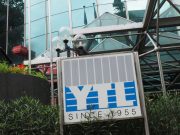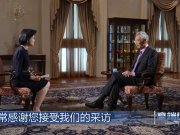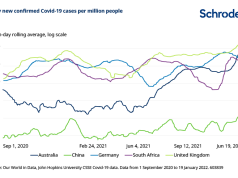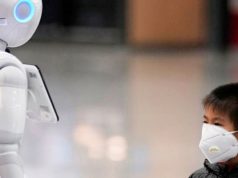US inflation hit its highest level since 1982 at the end of 2021, with the consumer price index (CPI) reaching 7% year-on-year. The figures were widely anticipated, but only add to pressure on the US Federal Reserve (Fed) to tighten monetary policy.
Speaking at his nomination hearing last week Fed chair Jerome Powell said that the US central bank would prevent high inflation from becoming “entrenched”. It looks as though this task will be made more challenging by the spread of Omicron which is disrupting supply chains as it surges through the country.
Both headline and core measures have risen
Looking at the latest inflation figures, rising commodity prices have played a role in boosting the annual consumer price inflation rate as tracked by the CPI. What makes this episode more worrying, however, is that underlying, or core inflation (CPI ex. food and energy) has also risen sharply and at 5.5% year-on-year is at its highest since 1991.
Consequently, although a moderation in energy prices such as that seen in December will help, unlike in previous cycles it is not sufficient to bring headline inflation down. This time we will also need to see core pressures easing.
Those core pressures are closely related to the supply side problems created by the pandemic which have meant that retailers have been unable to meet higher demand and have raised prices instead.
Changing preferences created by the pandemic have played a role as, unable to access services, people have increasingly gone online to buy goods. The change in demand patterns can also be seen in the jump in used and new car prices as people look to avoid public transport, for example.
Recent surveys had suggested that pre-Omicron, bottlenecks were beginning to ease. For example, delivery times and prices paid by firms had begun to reduce in the purchasing managers’ surveys.
Meanwhile, the broad New York Federal Reserve index of global supply chain pressures, had shown signs of peaking in December, albeit from a high level.
Disruption from Omicron threatens supply chains, particularly from China
However, that trend is likely to be interrupted in the near term by the rapid spread of Omicron. This is putting renewed pressure on supply chains as workers are forced into self-isolation, or worse into hospital.
Federal Express is warning of delays in deliveries and the backlog of shipping waiting to dock at Los Angeles and Long Beach ports is building up again. An estimated one in 10 dock workers are absent for Covid related reasons.
The situation in China is especially concerning. The government’s zero Covid policy means that a small outbreak of cases can lead to a whole city going into lockdown. Consequently, a number of firms like chipmakers Samsung and Micron, or car maker Volkswagen have had to adjust production following the restrictions on cities such as Xi’an.
Ports are also under pressure with the entire population of Tianjin facing testing after just 20 cases were discovered.
It seems unlikely that China will abandon its zero Covid policy, so given the country’s role in supplying goods to the world economy this suggests wider trouble ahead as her ports are disrupted. China’s goods exports have surged to record highs over the past year and have been particularly strong into the US in recent months helping meet the surge in demand.
By disrupting the supply side, Omicron threatens to push the US and world economy in a more stagflationary direction, a combination of slowing growth and accelerating inflation. Meanwhile, by restricting mobility and people’s ability to spend in the service sector, the variant is skewing consumer demand further toward goods, thus exacerbating the imbalance between supply and demand and prolonging the rise in inflation.
The latest inflation figures clearly show the acceleration in core goods prices. What is perhaps more concerning is the pick up in underlying services prices. This is largely driven by the housing market and tends to be cyclical in nature.
Shelter costs, which account for nearly one third of the overall CPI rose 4.1% in the year to December, the fastest pace since 2007 prior to the bursting of the housing bubble. The buoyancy of housing supported by low mortgage rates is apparent here and means that inflation is broadening out.
Fed rates to lift-off in March
From this perspective it looks as though inflation will continue to rise at the core level through the first quarter of the year, even as the headline ebbs. Thereafter as the effect of Omicron wanes we would expect supply chains and labour shortages to ease and bring some relief on prices.
However, this would be too late for the Fed who will see inflation remaining at peak levels when they meet on 15 – 16 March. Fearing that the pick-up in prices will feed into a tight labour market and push wages higher means that the risk of inflation becoming entrenched remains significant and they are likely to raise interest rates.
With the asset purchase programme due to be wound down that month the central bank will be free to adjust the cost of credit.
Looking beyond March, we expect rates to rise further this year and into next, to take the Fed funds rate to 1.5% by June 2023. Meanwhile, the central bank is expected to begin reducing its $8.7 trillion balance sheet from this October.
Omicron is helping to speed the Fed into action, but there is a risk that rates rise faster and further. If inflation becomes entrenched as a result of extended supply disruptions or the emergence of a wage price spiral, the Fed will have to act more aggressively.
We have previously described this in our supply side inflation scenario where the Fed funds rate peaks at nearly 3%.
Our view that interest rates will not have to reach these levels and that the peak, or “terminal”, rate will be lower reflecting our medium-term concerns over the strength of demand in the US. There is still pent-up demand to come through from the household sector as the savings built up in lockdown are spent.
This will be a one-off, however, and thereafter consumption will slow as spending patterns normalise. In the meantime, the impulse from fiscal policy will fade and seems unlikely to get any extra boost from President Biden’s Build Back Better plan which remains mired in Congress.
As a result, we expect supply and demand to come into better balance and inflation to moderate.
Coming back to today though, the more immediate story is one of rising stagflationary risks as Omicron extends disruption and the Fed steps up to bring inflation under control.






















-3_1-180x135.jpg)
























